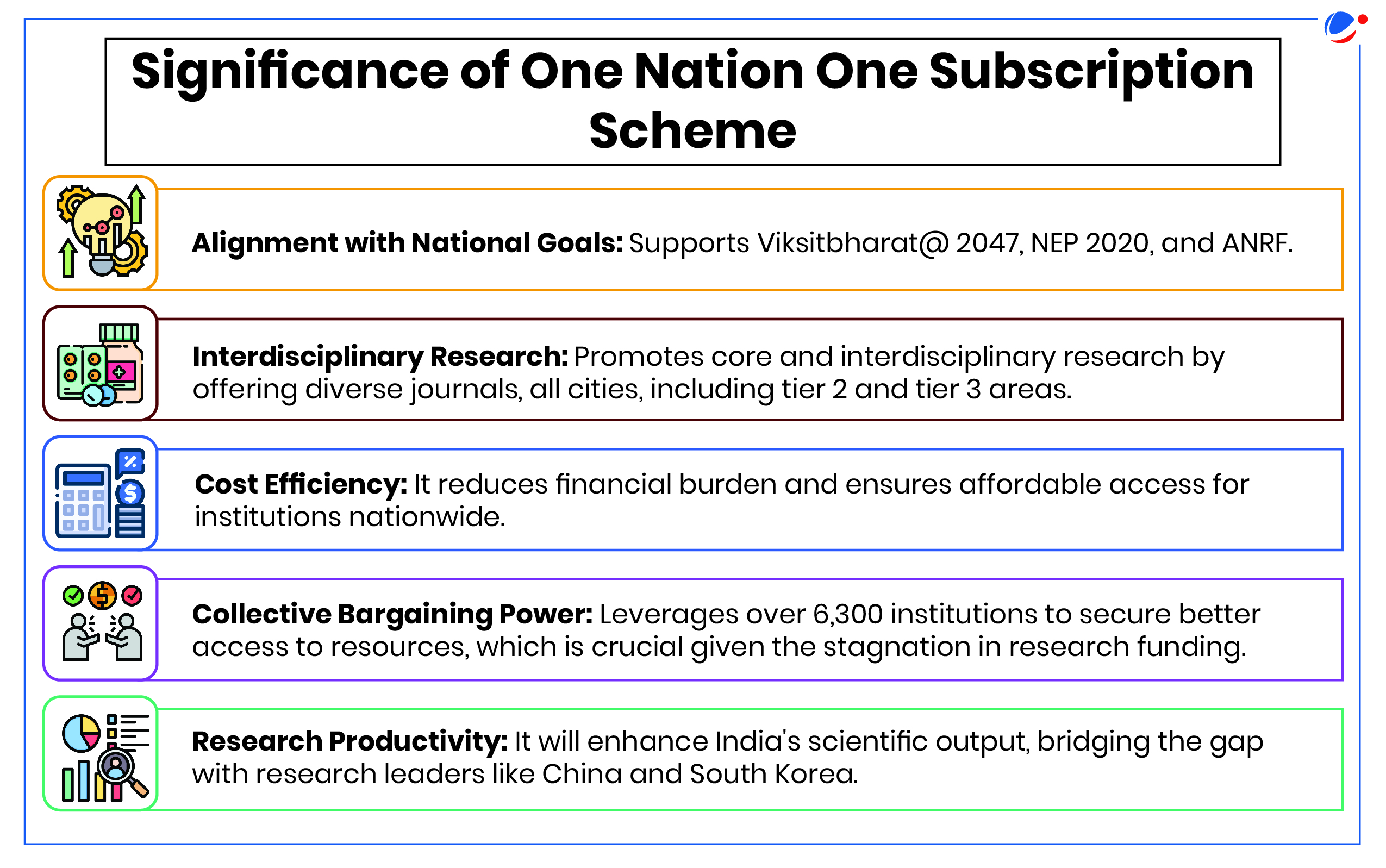Why in the news?
The Union Cabinet approved the 'One Nation, One Subscription' (ONOS) scheme to provide equitable access to scholarly journals in all public institutions.
About One Nation One Subscription Scheme
- Objective: To obtain national licenses for e-journal and database subscriptions across STEM and social sciences fields.
- Key Features
- Digital Access: Access to ONOS will be managed by INFLIBNET (Information and Library Network), a UGC center, offering a fully digital process for all institutions.
- Monitoring: The Anusandhan National Research Foundation (ANRF) will review the usage and publications of Indian authors periodically.
- International Journals: It will host 13,000 journals from 30 leading publishers, including Oxford University Press, Cambridge University Press, Elsevier Science Direct (including Lancet) etc.
- Financial Allocation: The government has allocated ₹6,000 crore for ONOS from 2025-2027 under a new Central Sector Scheme.
- Implementation Strategy: The Department of Higher Education (DHE) will provide a unified portal and conduct Information, Education, and Communication (IEC) campaigns to raise awareness.
What is the need of One Nation One Subscription Scheme?
- Profits from Public Funds: Academic publishing is a highly profitable industry, generating USD 19 billion in revenue with profit margins up to 40%.
- However, these profits are largely derived from public funds, yet concentrated in a few private companies.
- Countering Predatory Publishing: Numerous low-quality journals exploit Indian researchers for publication fees without proper peer review, undermining research quality.
- Removing Access Barriers: Subscription-based models restrict access to research due to high costs, limiting the ability of researchers from smaller institutions to collaborate globally.
- For ex- Nature Communications charges $6,790 per paper.
- Favourable Agreement Clauses: Indian institutions often sign publisher agreements that favor publishers' interests, like restrictive copyright transfers. This limits Indian researchers' control over their work.
- Reducing Financial Burden: In 2021, Indian authors paid ₹380 crore in Article Processing Charges (APCs) for Gold Open Access journals, highlighting the financial strain on researchers.

Issues with one nation one subscription
- Shift to Open Access (OA): With over 50% of research freely available, ONOS may become outdated.
- For ex- the U.S. will require all publicly funded research to be freely accessible by 2026, raising doubts about ONOS's future beyond 2025.
- Limitations of Nationwide Subscription: ONOS may prioritize popular journals, neglecting niche fields. This limits access for smaller communities and reduces research diversity.
- Commercial Publisher Dominance: ONOS risks supporting Western publishers with high profit margins (up to 40%), undermining public-funded research.
- Copyright Issues: Researchers often give up copyrights when publishing, letting publishers use their work without permission.
- For ex-Taylor & Francis allowed Microsoft to use its journals for AI training, but since authors lost copyright, Microsoft didn't need approval.
- Digital Content Preservation: Relying on publishers for content preservation is risky, as seen in the 2023 discontinuation of Heterocycles, a journal published by the Japan Institute of Heterocyclic Chemistry. This left 17,000 articles inaccessible.
- Other Issues: Lack of Support for Indian Journals; Transparency issues regarding selection, monitoring etc. under ONOS; Unreliable internet availability in tier 2 and tier 3 cities etc.
Way ahead
- Negotiating National Licenses: Aim for a 90-95% reduction in subscription costs, with favorable terms, including waivers on Article Processing Charges (APCs) for Indian researchers.
- Agreement Clauses: Develop a common model license agreement to protect institutional interests and ensure fair terms on IP, pricing, and renewals.
- Innovative Services: Build infrastructure to promote resource usage, ensure access, monitor trends, and provide training and support for sustainability.
- Promote Open Access (OA): Encourage OA and fair use of copyrighted materials, support OA journals, and provide funding for Article Processing Charges (APCs) for young researchers.
Anusandhan National Research Foundation (ANRF)
Functions:
Key Initiatives: PAIR Programme'Partnerships For Accelerated Innovation And Research' (Pair) Programme is designed to transform research and innovation in Indian Universities through hub and spoke model.
Organizational Structure:
|




